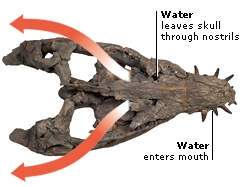DK Science: Below The Waves
While dinosaurs ruled the land, the ocean was the domain of many different families of marine reptiles, such as the nothosaurs, ichthyosaurs, pliosaurs, mosasaurs, and elasmosaurs. They were carnivores, preying on other sea creatures as well as each other. Although these reptiles spent their lives in water, they could not stay below the waves indefinitely. They breathed air, and had to swim to the surface to refill their lungs, before disappearing back into their underwater world.
Elasmosaurus was a member of the long-necked elasmosaur family. The sea giant had 72 vertebrae in its snaking neck, and its light skull was lined with vicious interlocking teeth. The name Elasmosaurus means “plate lizard” and refers to the large, platelike shoulder bones that covered its chest and formed its arm sockets. The huge muscles that powered its flippers were anchored to these bones.
| Family: Elasmosauridae |
| Lived: 66–69 million years ago (Cretaceous) |
| Habitat: oceans |
| Length: up to 14m (46 ft) |
| Weight: up to 3 tonnes |
| Diet: fish, squid, shellfish |
Like other members of the ichthyosaur family, Ichthyosaurus had a shark-shaped body. Fossils found in England and Germany show this sea reptile had a triangular dorsal fin, two pairs of flippers, and a forked vertical tail like that of a shark. In some fossils even pigment cells survive. These hint that Ichthyosaurus’s skin was a dark reddish-brown.
| Family: Ichthyosauridae |
| Lived: 206–140 million years ago (Jurassic) |
| Habitat: oceans |
| Length: up to 2 m (61/2 ft) |
| Weight: up to 90 kg (200 lb) |
| Diet: fish, squid |
Nothosaurus belonged to a family of small amphibious predators called the nothosaurs. It had a long, flexible neck and its fanglike teeth lined its jaws all the way back to its cheeks. Nothosaurus swam by flapping its powerful front legs and using its back legs for steering. Fossil specimens have been found in sea rocks in Europe and the Near East, which suggests they were mainly sea-going creatures, but they probably came on land to breed.
| Family: Nothosauridae |
| Lived: 240–225 million years ago (Triassic) |
| Habitat: coastal regions |
| Length: up to 3 m (93/4 ft) |
| Weight: up to 80 kg (176 lb) |
| Diet: fish, shrimp |
With a skull 3 m (10 ft) long and huge pointed teeth, Kronosaurus was one of the largest of the short-necked pliosaurs. A ferocious carnivore, it preyed on other marine reptiles, and lived in seas around present-day Australia and South America. Massive muscles in Kronosaurus’s flippers gave it a powerful downstroke. Perhaps while one pair of flippers was in the downstroke, the other pair was in the upstroke.
| Family: Pliosauridae |
| Lived: 110 million years ago (Cretaceous) |
| Habitat: deep oceans |
| Length: up to 10 m (33 ft) |
| Weight: up to 7 tonnes |
| Diet: fish, marine reptiles, molluscs |
Tylosaurus was a giant, long-skulled mosasaur, which was a family related to land lizards such as gila monsters. One of the most distinctive features of Tylosaurus was a hard, bony tip to its snout. Some fossil specimens show damage to the snout and this may indicate it was used as a ramming weapon for stunning prey. All mosasaurs had teeth in the roof of their mouth, as well as those lining their jaws.
| Family: Mosasauridae |
| Lived: 85–78 million years ago (Cretaceous) |
| Habitat: shallow seas |
| Length: up to 11 m (36 ft) |
| Weight: up to 7 tonnes |
| Diet: fish, turtles, other mosasaurs |
This pliosaur skull shows nostril holes on the outside of the snout. This animal also had two internal nostrils in the roof of its mouth. As it swam, water may have flowed through its mouth and into its internal nostrils, where scent particles could have been detected. The water then left through the external nostrils. Like modern sharks, pliosaurs may have sniffed the water to locate prey.
To order this book direct from the publisher, visit DK's website.

